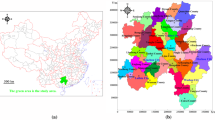Abstract
As a crucial link in debris flow disaster control, control engineering can be divided into geotechnical engineering and ecological engineering. Geotechnical engineering is less affected by climate and can play an immediate role in the treatment of debris flow in a short time. Ecological engineering has obvious regulating effect on surface runoff and erosion. Furthermore, there are few discussions on comprehensive treatment effect between geotechnical engineering and ecological engineering for debris flow. Therefore, taking the debris flow gullies with control engineering implemented in Wenchuan area of Sichuan Province as the research object, this paper puts forward an evaluation method of treatment effect comprehensively considering the geotechnical engineering and ecological engineering. It is mainly based on the impact of engineering on the formation conditions of debris flow and the damage of projects. The comprehensive treatment effect of geotechnical and ecological engineering for debris flow is analyzed. The corresponding evaluation indexes are extracted, including 5 first-class evaluation indexes such as landform factor and water source factor, as well as 11 s-class evaluation indexes such as the peak flow reduction rate, the sediment retention ratio and the LAI ratio. The Fuzzy-AHP method is used to establish the evaluation model of treatment effect. The evaluation results are graded. It is considered that the treatment effect of other debris flow gullies is medium or above except that two gullies are poor. The evaluation results are consistent with the actual investigation, which provides a reference for the control of debris flow in this area.














Similar content being viewed by others
References
Changqing Z, Xiaoqiang Li (2004) Effects of terrace on soil and water conservation in red-soil Hilly Area. Bull Soil Water Conserv 6:79–81 (in Chinese)
Chen Ningsheng Z, Haibo LY et al (2013) Analysis of benefits of debris flow control projects in southwest mountain areas of China. J Chengdu Univ Technol (Science & Technology Edition) 40(1):50–58 (in Chinese)
Dehui Z, Tiefan P, Zhiping F et al (1996) Simulation of canopy interception by Mongolian pine[J]. Chin J Appl Ecol 2:134–138 (in Chinese)
Docker BB, Hubble T (2008) Quantifying root-reinforcement of river bank soils by four Australian tree species[J]. Geomorphology 100(3–4):401–418
Han Yongshun W, Jing WUM et al (2018) Hazard assessment on potential post- earthquake debris flows in Wenchuan County[J]. Eng Sci Technol 50(3):158–168 (in Chinese)
Harmon ME, Sexton J (1995) Water balance of conifer logs in early stages of decomposition[J]. Plant Soil 172(1):141–152
Hubble T (2004) Slope stability analysis of potential bank failure as a result of toe erosion on weir-impounded lakes: an example from the Nepean River, New South Wales, Australia. Marine & Freshwater Res, 55.
Hui F, TIAN Q, JING Z, et al. (2003) Reasearch and quantitative analysis of the correlation between vegetation index and leaf area index. Remote Sens Inform, (2): 10–13. (in Chinese)
Iii R (2005) Ecological engineering for successful management and restoration of mangrove forests. Ecol Eng 24(4):403–418
Ikeya H (1989) Debris flow and its countermeasures in Japan[J]. Bull Eng Geol Env 40(1):15–33
Jiangang C, Xiaoqing C et al (2015) An experimental study of dilute debris flow characteristics in a drainage channel with an energy dissipation structure. Eng Geol 193:224–230
Huebl, J (2005) [Springer Praxis Books] Debris-flow Hazards and Related Phenomena || Debris-flow mitigation measures
Lin WT, Lin CY, Chou WC (2006) Assessment of vegetation recovery and soil erosion at landslides caused by a catastrophic earthquake: a case study in Central Taiwan. Ecol Eng 28(1):79–89
Manbeian, T (1973) The influence of soil moisture suction, cyclic wetting and drying, and plant roots on the shear strength of a cohesive soil. University of California, at Berkeley, Calif
Mitsch WJ, Jørgensen SE (2003) Ecological engineering: a field whose time has come. Ecol Eng 20(5):363–377
Mizuyama T (2008) structural countermeasures for debris flow disasters. International Journal of Erosion Control Engineering
Odum HT (1962) Man in the ecosystem. In: Proceedings of the Lockwood Conference on the Suburban Forest and Ecology. Bull. Conn. Agr. Station, Storrs, CT, pp. 57–75.
Okubo S, Ikeya H, Ishikawa Y et al (1997) Development of new methods for countermeasures against debris flows. Springer, Berlin Heidelberg
Peng C, Lin Y (2013) Debris-flow treatment: the integration of botanical and geotechnical methods. J Resour Ecol 4(2):97–104
Tao Hu (2017) The research on formation mechanism and mitigation measure of large-scale debris flow in the Wenchuan earthquake area. Chengdu University of Technology, Chengdu (in Chinese)
Wang F , Wang J , Chen X , et al. Experimental study on debris-flow velocity control mechanism with baffles in a drainage channel[J]. Bulletin of Engineering Geology and the Environment, 2021, 80(10).
Wei Z, Bo J (1992) Progress of analytic hierarchy process. Math Practice Theory 3:63–71 (in Chinese)
Wu HL, Feng ZY (2006) Ecological engineering methods for soil and water conservation in Taiwan. Ecol Eng 28(4):333–344
Zigang Li, Zonghui J (2004) Effect of forest belt intercepting debris flow. Technol Soil and Water Conserv 1:39–40 (in Chinese)
Funding
This research was supported by the Strategic Priority Research Program of Chinese Academy of Sciences (Grant No. XDA23090403), the Second Tibetan Plateau Scientific Expedition and Research (STEP) Program (Grant No. 2019QZKK0902), and the Natural Science Foundation of Sichuan (Grant no. 2022NSFSC1032).
Author information
Authors and Affiliations
Corresponding author
Ethics declarations
Conflict of interest
The authors have not disclosed any competing interests.
Additional information
Publisher's Note
Springer Nature remains neutral with regard to jurisdictional claims in published maps and institutional affiliations.
Rights and permissions
Springer Nature or its licensor (e.g. a society or other partner) holds exclusive rights to this article under a publishing agreement with the author(s) or other rightsholder(s); author self-archiving of the accepted manuscript version of this article is solely governed by the terms of such publishing agreement and applicable law.
About this article
Cite this article
Zhang, W., Liu, J., Li, D. et al. Evaluation of comprehensive treatment effect of geotechnical and ecological engineering for debris flow: case of Wenchuan County, Sichuan Province. Nat Hazards 116, 769–794 (2023). https://doi.org/10.1007/s11069-022-05698-w
Received:
Accepted:
Published:
Issue Date:
DOI: https://doi.org/10.1007/s11069-022-05698-w




